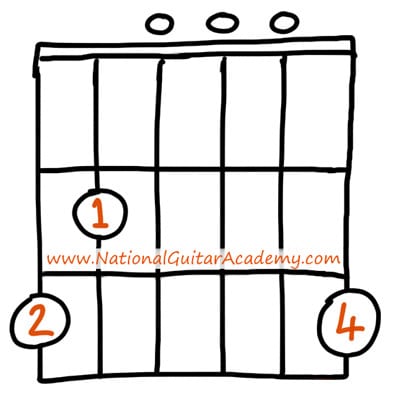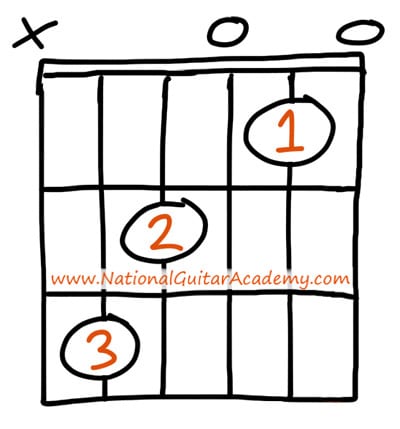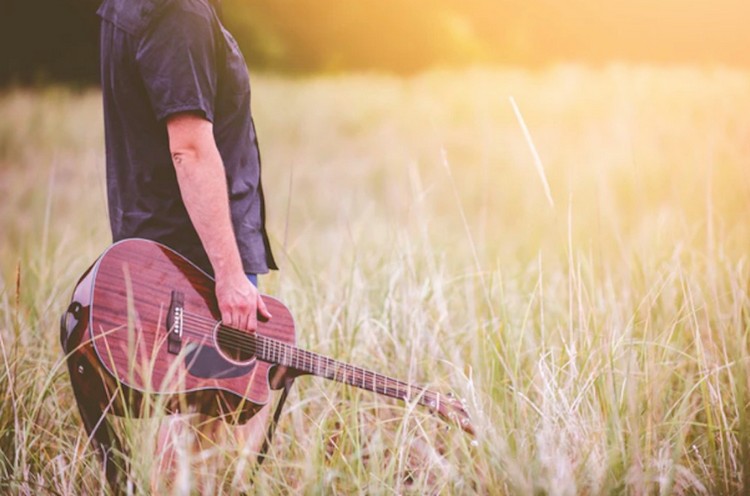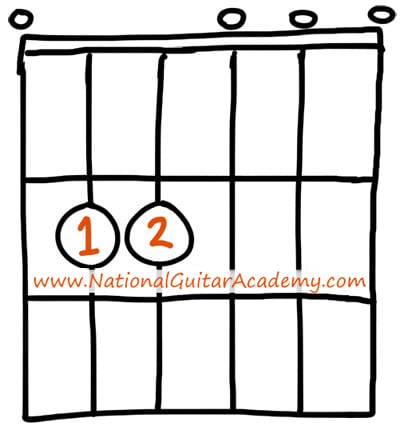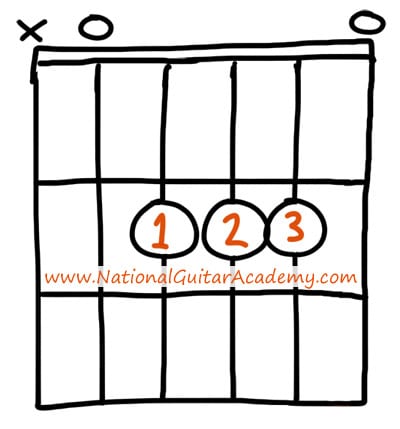Check out these guitar arpeggios exercises to keep your fingers sharp and your picking accurate!
Over 100,000 guitar-learners get our world-class guitar tips & tutorials sent straight to their inbox: Click here to join them
In this free lesson you will learn…
- How to find the notes in a chord
- How to play an arpeggio & what it is
- How to create movable chord shapes
- Why you should use your ears & not your eyes when playing!
Guitar Arpeggios Exercises: Pulling Chords Apart
Guitar arpeggios are an interesting and fun way to level up your playing and get more familiar with how to work the fretboard.
- The simplest way to understand an arpeggio is that it is a chord on the guitar that is played one note at a time as opposed to strumming all the notes together.
- Guitar arpeggios exercises can be expanded from using simple chord shapes that you already know and love to finding those same tones in different places on the fretboard.
- Arpeggios are used in combination with scales to make up cool guitar licks that you can use in improvising a lick or a whole solo.
Not only are they great for warming up the hands, they also are extremely useful tools for songwriting.
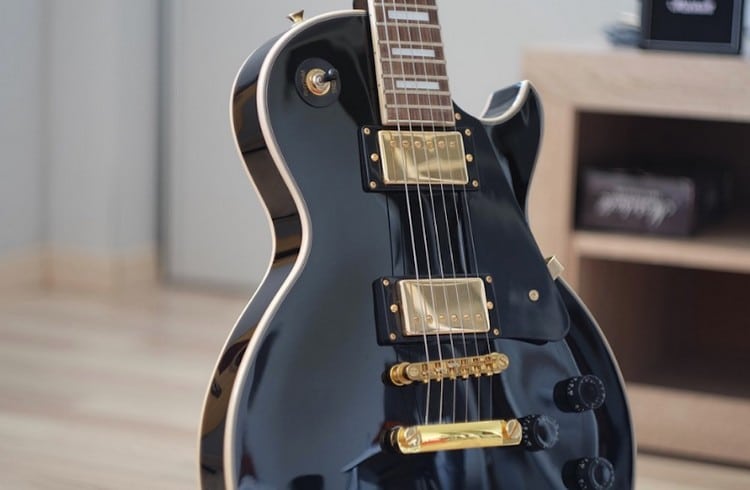
If this sounds a little intense, remember that arpeggios are just chords.
You probably know some chords already, and therefore you can play some arpeggios!
- The chords you know are all you need to get started playing these guitar arpeggios exercises, so we’ll begin there.
- After you get comfortable playing chords one note at a time, you can move on to finding those chords in other places on the fretboard.
- Learning notes in their various positions helps us greatly when it comes to learning the fretboard inside and out.
- Where it really gets fun is combining chords in your guitar arpeggios exercises, the shapes you know and the sequences you’re about to learn. Let’s dig in!
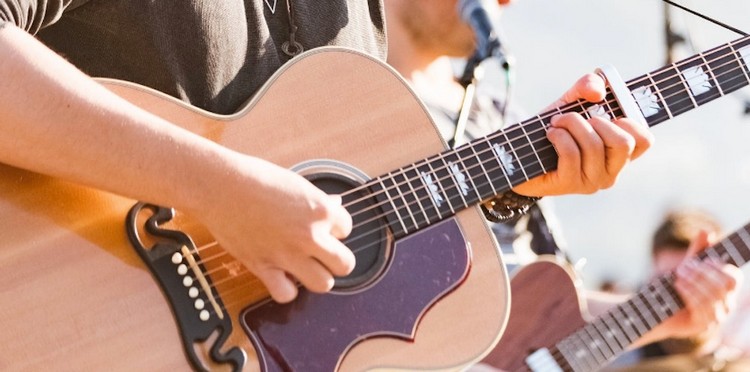
Beginning Guitar Arpeggios Exercises
Major and minor guitar chords have only three notes in each.
Although you strum a chord that uses between four and six strings, some of the notes repeat.
For example, the G major chord goes G, B, D, G, B, G. Three Gs!
Chords repeat notes in this way to give themselves more width in their tone. Playing each note only once in a chord will sound much thinner than playing a set of three repeating notes over two octaves. Listen for each note to hear where it repeats!
Your first arpeggio is going to be part of the G chord, so go ahead and make a G chord on your guitar.
G major (320003)
(If you don't understand the above image please read our article "How To Read Guitar Chordboxes In 60 Seconds". It will make everything clear!)
Instead of strumming it, start at the low E string and play each of the strings in order, one string at a time. Ta-da! Arpeggio!
Since rhythm is always important in music, you can eliminate the high E from your arpeggio and play from the low E to the B string and back, and you’ve got the first of your guitar arpeggios exercises.
In tablature form, it looks like this:

If you need a little help decoding tablature, remember that the strings are upside down!
You can also check out these lessons for a little more in-depth information:
Reading Guitar Music: The Ultimate Guide
Play the above exercise repeatedly and with a metronome, trying to keep a steady beat and listening to make sure all the strings are sounding clearly. There’s nothing like an arpeggio to get you honest with yourself about your tone!
You can try these guitar arpeggios exercises using any chords you like, but a really nice one to follow up the G chord arpeggio with is the C chord arpeggio.
C major (x32010)
Play this arpeggio in the same manner as the G, only starting on the A string, like this:
Make use of alternate picking here to catch each note with your pick, and play slowly to hear what you’re playing clearly.
Learn 12 EASY beginner chords with our popular guide

✅ Stop struggling. Start making music.
✅ Learn beginner-friendly versions of every chord.
This is our most popular guide and it will improve your chord ability quickly! 😎
Get your own personalised guitar-learning plan 🎸
Get a custom guitar-learning plan here: Click here for GuitarMetrics™
World-Class Guitar Courses 🌎
Learn from the world's best guitar educators: Click here for our guitar courses

Once you’ve got the G and the C arpeggios down, try alternating between them!
Pro Tip: Stringing arpeggios together isn’t just for exercising – it makes for amazing melodic phrases as well. As you learn new chords, learn their arpeggios and play them against other chords that you already know.
This is by far the best way to not only understand chords, but arpeggios themselves also.
Guitar Arpeggios Exercises: Fingers Versus Flatpick
It may have already occurred to you that arpeggios form the basis of a whole lot of fingerstyle guitar.
If you are interested in pursuing fingerstyle guitar further, check out this lesson:
Fingerstyle Guitar Lessons: 5 Easy Ways to Sound Amazing
You can play all of these guitar arpeggios exercises with your fingers, using your thumb for the root or low note and your other fingers across the strings.
- The drills in this lesson, in fact, are a pretty good low-key introduction to fingerpicking. They can help you even out the sound between your thumb and your other fingers.
- You can also use the guitar arpeggios exercises to practice hybrid picking, a technique used by Glen Campbell, Rory Gallagher and Chet Atkins.
- You hold the flatpick between your thumb and first finger, and use your other three fingers to pick the strings as well.

For you flatpicking traditionalists, there is still some variety to be had when you’re practicing your guitar arpeggios exercises.
When you’re beginning to play one string at a time on the guitar, it can be challenging to teach your strumming hand where each individual string is.
Resist the temptation to look down at the strings! There’s always somewhere else to look while you’re playing – your audience, your fretting hand, some music, some other musicians, the TV in the back of the bar – and it’s best to learn not to rely on your eyes.
As much as this seems counter-intuitive, relying on your ears helps them to become more focused on identifying notes as they come up. The more you hear something and identify it, the more familiar it becomes!
Soon enough, you will absolutely be able to find the strings with your strumming hand without looking. Keep your hand motion small and stay close to the strings.
- Keep it simple at first. You can pick with all downward picking and nobody will get hurt! It’s a good way to teach your hand the distance between the strings.
- If you are interested in changing it up a bit, you can try alternate picking, where you pick down-up as though you were strumming a tiny one-string guitar. Here is a great introduction to alternate picking.
- There is also such a thing as sweep picking, which is a way shredders like Yngwie Malmsteen get all those notes in! We’ll worry about sweep picking later. For now, pick your method and continue!

Pro-Tip: Take your time! Practicing guitar arpeggios exercises can help you accomplish so much more than just learning where the notes are. You can simultaneously work on rhythm and tone by using a metronome and listening for notes that sound muffled.
One Fantastic Song, One Fantastic Arpeggio Drill
This gorgeous REM song is a great way to get used to playing arpeggios using chords you already know.
There are a lot of songs that are not only fun and satisfying to play but are also useful guitar arpeggios exercises.
All Peter Buck is doing in this song, except for the bridge, is playing arpeggios.
The section of “Everybody Hurts” that you can use for your arpeggio exercise is the verse. Here are the chords you need.
D (xx0232)
G (320003)
Em (022000)
A (x02220)
To play the verse, alternate between the D and the G chord four times, using this arpeggio sequence.

Do the same for the Em and A chords three times, and then head back to D.
If you are interested in learning the whole song, here is a chord chart to supplement the above for “Everybody Hurts.”
Pro Tip: Try playing each chord as an arpeggio to step up your practice routine! This practice concept can be applied to any song. It won’t sound much like the original, but it will surely give your fingers a well-needed workout!
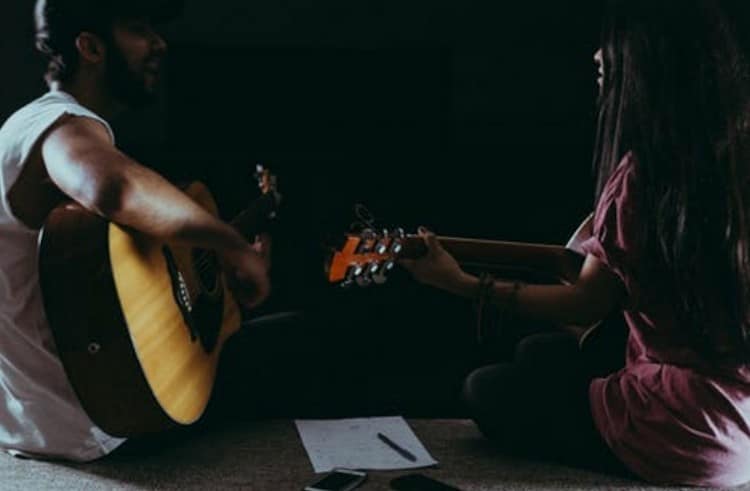
Finding The Notes In Your Arpeggio
Moving beyond familiar chord shapes for your guitar arpeggios exercises involves learning a little bit about what’s in a chord.
You don’t have to have all of this memorized right away, but it will help you to understand the entire system of arpeggios on the fretboard to know a little bit about what chords are made of.
- In basic three-note chords, called triads, there is a root (the note the chord is named after), a third (the note that makes the chord major or minor), and a fifth (the stabilizer note that gives context to the other two notes so you can identify the chord).
- We’re going to expand the G major arpeggio so that you’re playing all three notes in the G major chord, in order, through two octaves, or past the next G to the next G.

This is one of the most useful guitar arpeggios exercises because you can hear each note – root, third, fifth, root, third, fifth, root – in order on the way up and down the sequence.
Remember how the third is the note that determines whether the chord is major or minor? That means that in order to get yourself a G minor arpeggio, all you have to do is change the third!
- To make a major chord minor, the third comes down by a half step, or by one fret.
- In some cases, simply lowering the note by one fret isn’t really an available way to do it, so you have to find that note on a different string.
For the G minor arpeggio, we need to find the thirds, which are Bs, and lower them to B flats. It will look like this.

If you are interested in finding similar easy guitar arpeggios exercises, you can take a look at this practical lesson: Guitar Arpeggios: The Ultimate Guide.
We like to go into plenty of detail to make sure all of the concepts we talk about are easy to practice and understand. If you want a glimpse at our whole catalog of lessons, click here.

Download our lead guitar cheat-sheet to make things easier
It's hard to understand which scales work with which keys.
So we created a cheat-sheet! A key and scale-finder that you can use again and again.

Get your personalised guitar-learning plan 🎸
Get a custom guitar-learning plan here: Click here for GuitarMetrics™
World-Class Guitar Courses 🌎
Learn from the world's best guitar educators: Click here for our guitar courses
Guitar Arpeggios Exercises: Making Them Moveable
The G major arpeggio above can be moved up the neck, making it one of a few versatile guitar arpeggios exercises you can use to really expand your playing.
Having a moveable pattern means that you can place your starting point on any fret of the starting string, and the note on that fret is the arpeggio you are playing.
There are major and minor guitar arpeggios exercises that are moveable, so that without learning 12 different things, you can play 12 different arpeggios by learning just a few patterns.
Here’s what happens when you move the G major arpeggio we’ve just discussed up two frets:

G plus a whole step, or two frets, is A in the world of guitar, you’ve just magically transformed the G major arpeggio into an A major arpeggio!
With this handy fretboard chart, you can figure out where on the sixth string you need to begin to play the guitar arpeggios exercises that you want.

If you take the C major arpeggio and move it up the neck, you get a lovely moveable pattern that you can use for another set of guitar arpeggio exercises.
Moving the C major arpeggio up two frets gives you this moveable pattern.

Pro-Tip: Notice that the G arpeggio moved up two frets contains the A chord shape?
In the world of guitar arpeggios exercises, the G shape and the A shape are the same thing! Notice that the C arpeggio moved up two frets contains the D chord shape?
This is a great insight into how the guitar functions, particularly with moveable shapes. A game-changer.

The Grand Arpeggio!
There are few things more satisfying than figuring out a workable way to travel up and down the fretboard, and arpeggios are a great way to get there.
- This is another moveable shape, but because it is designed to move you through several positions on the guitar, it only covers a few spots on the acoustic guitar.
- It is more versatile for electric guitars, or acoustics with cutaways so you can reach the higher frets.
Here is a variant of the G major arpeggio that travels up and down the neck.

This G major arpeggio travels over three octaves, giving you a much larger range of the guitar to play with.
Also, if you start slowly and with a steady beat, perhaps assisted by a metronome, you will soon be able to figure out the easiest fingering for you.
Keep increasing the tempo as you gain control over these guitar arpeggios exercises, but be sure to play them at a variety of tempos all the time to maintain control!
For a great YouTube set of guitar arpeggios exercises by a genius instructor, please check out Steve Stine’s awesome intro to arpeggios here.

Further Resources For Guitar Arpeggios Exercises
We hope that by now you’re starting to get the idea not only of how to play arpeggios, but also how they work as systems on the guitar.
Whether you need more support with the concepts we’ve discussed here or you get it and you’re ready to go on, there are plenty of places you can find extensive discussions of arpeggios.
We recommend these two great books of exercises:
Recommended Resources
If you enjoyed this free guide to playing arpeggios as exercises, you’ll love the other content we’ve got for you below!
- 3 Easy Ways To Play The A Chord On Guitar
- Am Guitar Chord For Beginners
- Guitar Tabs For Beginners: 20 Easy Songs That Sound Great
- What’s The Best Beginner Guitar?
- 14 Easy Guitar Chords For Beginners
What Type of Guitarist Are You?
Take our 60-second quiz & get your results: Take The Quiz
Join the world's best online guitar school 🌎
- Get your own personalised guitar learning plan (customised just for YOU).
- World-class online guitar courses. Learn at your own pace.
- Community Campus & Learning Forum - A friendly community! Connect with our team & students. 😊
- Beginner Song library with chordsheets, tabs and tips. (Songs suitable for all levels!)
- Regular live streams, seminars and Q&A sessions - Learn from world-class guitar educators. Get all your questions answered!
Click here to learn more about National Guitar Academy membership 
Cool Guitar T-shirts 😎
Look cooler! Check out our merch: Click here to see our merch store
Want free guitar tips and video lessons delivered to your inbox?
Join over 100,000 guitar-learners and subscribe to our guitar-tips-by-email service. (It's free.)
We'll send you a series of lessons that will move you to the next level of your guitar journey.
Learn how everything fits together quickly, easily and effectively. We share ninja tips (for instant fun!) but also timeless fundamentals that will deepen your understanding.

Popular Lessons
How To Learn Guitar: An 11-Step Programme For Beginners
How To Choose The Perfect Beginner Guitar
More Cool Guitar Stuff
Learn about National Guitar Academy: About Us
Join us on Facebook for daily guitar tips.
Listen to our Learn Guitar Podcast for rapid guitar progress.
Check out our free chord lessons.
Get our best guitar tips & videos
Where should we send it?
Where should we send it?
Get our best guitar tips & videos

